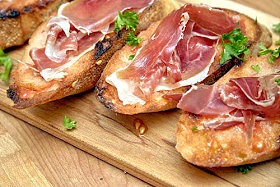
Pa amb oli is the snack par excellence in Majorca, “pa amb oli” literally means bread with oil, usually eaten at any time as breakfast, dinner, appetizer or snack. Pa amb oli bears a strong resemblance to the Catalan pa amb tomàquet or the Italian Bruschetta.
The ingredients are: pa moreno – a sort of dark rye bread (preferably artisan), vine-ripened tomatoes, Mallorcan olive oil, garlic and salt.
Preparation method: toast the bread until crisp, rub one side of each slice of bread with a cut side of the garlic clove, then rub the same side of each slice with the cut side of a tomato half, pressing a little to squeeze some of the pulp and seeds onto the bread, then drizzle olive oil over the tomato and sprinkle with salt. It is served with a topping of different things such as jamón serrano (dry-cured ham), cheese, sobrassada (traditional Majorcan sausage), anchovies, olives and if you find it in your local shop or <link en mallorca other-information english-details article wochenmaerkte-auf-mallorca.html _blank external-link-new-window markets in>markets, try it with fonoll marí (rock samphire).
Pa amb oli is definitely one of the simplest yet most deeply rooted dishes in the culture of the Mallorca and like many things in life… “less is more”. Bon profit! (bon appétit!).
Pa amb oli is a yummy snack great for sharing with friends and family while holidaying in Mallorca, enjoy this classic Majorcan treat!.
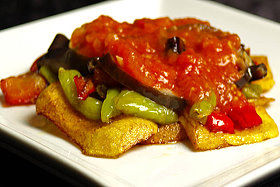
Cold, warm or lukewarm, as starter, main or side dish (perfect for BBQ accompaniment), Tumbet is a truly versatile dish, Tumbet is a traditional Majorcan recipe and a perfect example of the now so in vogue Mediterranean cuisine, preparation may sound a bit laborious but once you start in less than one hour and a half all is ready, time well worth to invest in this delicious Tumbet, here we go...
This is how my mother (María) makes the Tumbet, we have eaten it at home for as long as I can remember:
Serves approximately 4 - 5
2 medium aubergines cut into half centimeter slices and sprinkled with salt
2 medium courgettes cut into half centimeter slices
Olive oil (to fry all ingredients)
3 - 4 big potatoes (sliced thinly)
2 red peppers (chopped)
3 green peppers (chopped)
4 - 5 garlic cloves
5 - 6 tomatoes (skinned and chopped), you can also grate them, it's much easier and faster (or if you are in hurry, you can also replace them with a good tomato sauce from the supermarket)
Salt and pepper to taste
Leave the aubergine slices in a colander for while which have been sprinkled with salt, this will help them to lose all bitter (sometimes they are). Heat the olive oil in a pan and fry the potato slices until golden and crispy, while frying the potatoes, add all garlic cloves (unpeeled) and they'll transfer a wonderful taste to the oil and consequently to the rest of the ingredients, lay the potato slices along the bottom of a tray and season with salt. In the same oil, fry the aubergine slices and put them in the tray on top of the potato slices, afterwards the courgettes (same procedure as the aubergines), continue with the red and green peppers and transfer them to the tray on the top of the courgettes. Now in the same pan (obviously with less oil) make the tomato sauce (sprinkle with some sugar), cook for about 30 minutes and pour over the vegetable casserole. Now two options: you can leave it how it is or you can transfer the tray to a 180 degree centigrade oven and bake for about 10 minutes, both ways are good (my mother doesn't put it in the oven).
Now it's your turn, you can make it at home or next time you visit Mallorca, remember to include it in your list of "must try" dishes.
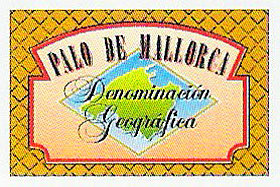
Palo de Mallorca is a spirit obtained by the maceration and/or infusion of cinchona bark and gentian root (gentina lutea), bark from various species of the Cinchona is the source of quinine, used to treat malaria. Cinchona bark extracts are also used in tonic water, aperitifs (like the Palo de Mallorca), soft drinks, and even ice cream. Cinchona was named after the wife of an obscure viceroy of 17th century Peru, the Countess of Chinchon (Chinchon is a Spanish town 50 km southeast of Madrid) which according to legend, she was the first European ever to be cured from malaria fever, she brought cinchona bark with her when she returned to Europe in the 1640s.
With the time and to mitigate the original bitter taste these extracts, sugar concentrates of grapes, figs and carobs were added. These extracts sugary reheated in order to concentrate and therefore was caramelised sugar and dark and found the taste masking the bitterness. This syrup had a relatively limited life as the product fermented very easily to they decided to add alcohol consequently the Palo de Mallorca was born. There are currently 8 registered Palo producers making a total of around 120,000 liters per year.
Palo de Mallorca is very dark and viscous, when stirred - the walls of the glass get a beautiful caramel colour, it is aromatic, but not too much, the predominating aromas are alcohol and caramel with a light woody touch reminding to licorice. This Majorcan aparitif may be taken either straight, slightly chilled, on the rocks or mixed with soda.
In 1993 the Regulation for the Palo de Mallorca Geographical Designation was approved, thus protecting this geographical name and to guarantee the quality of the product.
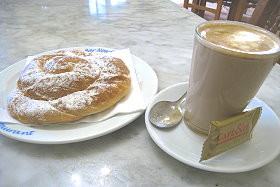
The ensaimada is definitely one of the stars of the Majorcan cuisine, the desert par excellence, no celebration is complete without the ensaimada. The ensaimada dates back to the 17th century, is made from strong flour, water, sugar, eggs, mother dough and pork lard. The name ensaimada comes from the Mallorquin word "saïm" which means pork lard. The dough is rolled up into a long cylinder which is then wound up into a snail-like shape. Sizes range from small ensaimadas (approx. 20 cm diameter) which are normally eaten from breakfast to huge ones for big celebrations.
A lot of variants of ensaïmada exist but the most common are: Llisa (plain) with no additional ingredient or topping. Filled with "cabell d'àngel" (angel's hair) which is a sort of jam made with squash (Cucurbita ficifolia). Topped with apricots. Topped with "tallades", that is slices of sobrasada and "calabazate" (preserved pumpkin candied with sugar). Filled with custard, cream, chocolate or turrón paste. If you are in the mood to prepare an ensaimada yourself, you can, you'll find a lot of recipes in the Internet but do bare in mind that you will need a lot time (hours) and eventually the result will not be as desired, the best is to buy them, all bakeries in Mallorca sell them do try to go to good one, my favorite ensaimadas are the ones from Pastelería Mir located on the main road of Es Coll d’en Rabassa in Palma.

In the south our Majorca and very close to the wonderful virgin beach of <link en mallorca beaches details place detail.html _blank external-link-new-window trenc beach in>Es Trenc is the home of the flor de sal ("flower of salt" in Spanish and Mallorquin) also known as "caviar of salt", like other sea salts, flor de sal is harvested by evaporating sea water, however, to harvest flor de sal, workers gently skim the top layer of the sea salt from partially evaporated pools, before it sinks to the bottom again. These salt crystals are very fine, light, and delicate, and must be handled with care and exposed to minimal moisture, just the premium, top layer of the salt bed is used. Unlike processed salts, flor de sal is a natural source of potassium, calcium, magnesium, copper and iodine. The taste is a delicate balance of the numerous salts, minerals, and micro-nutrients, this is truly one of the finest salt available and comes from Mallorca.
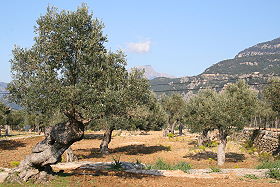
Spain, is the biggest and best-known olive oil producer in the world with approximately 42% of the total world production. Some of the most common olive varieties used are Manzanilla, Arbequina, Picual and Cornicabra ranging from golden yellows to bright greens, olive oils run the gamut from mild and fruity to spicy or even bitter.
The olive tree (Olea europaea) is typically Mediterranean and is well suited to the climate of Majorca, while visiting the island you must have probably noticed that Mallorca is full of this iconic trees, especially in the Tramuntana mountains where olive trees, some of them are over 500 years old, form a part of the landscape, these impressive specimens are real living statues. The olive tree has been cultivated for centuries on Mallorca and both the fruit and the oil are deeply rooted in the Majorca way of life and gastronomy.
Mallorcan olive oil is usually produced using any or a combination of these olive varieties: Arbequina, Picual or Mallorquina. These three varieties of olive allow the producers to create very high quality olive oils with very unique flavors and aromas. The Arbequina olive provides the oil a fruity taste, the Picual is slightly bitterer and the Mallorquina brings a subtle hint of almonds. The oils produced using any one of these olive varieties or a combination of them will surprise you for its amazing flavor and aroma.
Needless to say that olive oil, particularly extra virgin olive oil, has a host of health benefits so if you are still not a regular consumer of it, you'd better go for it and start to enjoy and feel the benefits of the "liquid gold".
A very nice and interesting plan for your next holidays in Majorca could be some olive oil tasting tours, visit some oil mills and discover the phases of the olive pressing process and the secrets for a good extra virgin olive oil.